
What's the Economic Difference Between a Street and a Road?
May 23, 2014
When Does it Cost Too Much to Save a Human Life?
May 25, 2014My new Starbucks has a drive-through.
If you look at a high shelf near the window through which the baristas hand the coffee and food to drivers, you see a screen with little cars and numbers. Changing from green to yellow to red, the color of each car indicates the wait time for that driver. Explained to me by my very knowledgeable barista Josh: green is excellent, yellow means you are close to the deadline and a red light indicates the car has waited too long. The goal is to serve each customer in no longer than 3 minutes. Drinks they can process quickly but heating food slows them down.
So where are we going here? For businesses and consumers, the drive-through is all about thinking at the margin.
The drive-through provides a revenue boost for the store while requiring only a little extra land, labor and capital. One of my students said she now is able to grab a coffee at the drive-through on the way to school whereas before she went to Dunkin’ Donuts because it was faster. Josh also said the drive-through generates more large to-go orders and coffees for moms with kids.
Achieving a balance among speed, accuracy and customer service has got to be tough. Friendlier customer service can add minutes while speed might mean less accuracy. According to a 2013 Drive-Through Performance Study, McDonald’s is slowing down. With a drive-through wait of 189.5 seconds, it exceeded the industry average by 9 seconds. By contrast, at 133.6 seconds (amazing) Wendy’s was the fastest. As for accuracy, Chick-fil-A ranked highest at 91.6% while Burger King, at 82.3% ranked last. Starbucks was not included in the study.
Our bottom line? Focusing on how much extra we do, marginal analysis for drive-throughs takes us to how much extra speed, accuracy and customer service we can create while using less extra land, labor and capital. Starbucks CEO/President and founder Howard Schultz, though, took us to the most important margin when he called the drive-through a “high [profit] margin store format..”
How does your Starbucks or McDonald’s drive-through optimize time, accuracy and friendliness? Do they have the L.E.D. car display that creates more productivity and pressure? It would be interesting to hear your stories.
![econlifelogotrademarkedwebsitelogo[1]](/wp-content/uploads/2024/05/econlifelogotrademarkedwebsitelogo1.png#100878)



